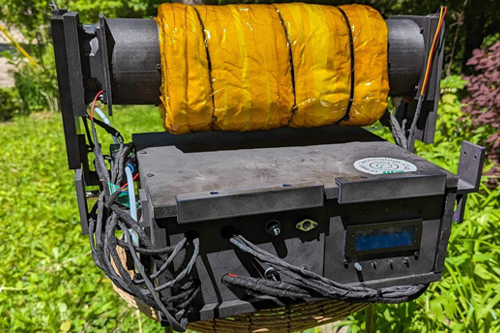Media
Contact
Communications Specialist
Faculty of Engineering
Spencer Engineering Building
Room 2072
Western University
Tel: 519-661-2111 ext. 87015
Email: engineeringcomms@uwo.ca
Western Engineering students receive Best Research Award at Global Carbon Removal Challenge

Western Engineering students (L-R) Sarah Lacroix, Eric Suszek, Kierra Holowachuk, Liam Israels, Ethan Milroy, and Lewis Klug display their Best Research Award at Carbon Unbound as part of the Carbon Removal Challenge. The Award was 3D printed by Carbon Upcycling which captured CO2 emissions from a natural gas plant and stored it in the award which is made up of 7% CO2. (Photo submitted)
Western Engineering undergraduate students received the Best Research Award at the OpenAir Carbon Removal Challenge held recently in New York.
The initiative is a worldwide challenge for students to create new processes, approaches and prototypes to remove carbon from the land, waters, or air.
“Being selected as a finalist and also receiving an award at the OpenAir’s Carbon Removal Challenge is very exciting for the team as it confirms the strength of the design,” shared Kierra Holowachuk, a mechatronics student and vice president of events for the Western Engineering Green Technology Club.
“Furthermore, the judges' insightful feedback offered additional opportunities for learning and growth. Having the chance to showcase our solution in New York to approximately 400 business leaders, investors, buyers and policymakers is an experience I will cherish for a lifetime and I am genuinely grateful for the opportunity.”
One of five teams to make it to the finals, their project was the creation of a fully automated Direct Air Carbon Capture (DACC) device. This device was developed through two capstone projects from the Western Engineering Green Technology Club advised by professor Joshua Pearce. The open-source device employs a temperature swing approach, utilizing a chamber to capture carbon dioxide from ambient air through sorbent material.
 “A fan is turned on which pushes ambient air into a chamber allowing carbon dioxide to be captured by the sorbent (the material that adsorbs the carbon dioxide). After it is saturated, the airflow is cut off, and the chamber is heated to release the captured CO2 to be stored or used,” explained Holowachuk.
“A fan is turned on which pushes ambient air into a chamber allowing carbon dioxide to be captured by the sorbent (the material that adsorbs the carbon dioxide). After it is saturated, the airflow is cut off, and the chamber is heated to release the captured CO2 to be stored or used,” explained Holowachuk.
Liam Israels, a mechanical student, club president and co-founder further explained that one of the main energy inputs to current solid sorbent DACC devices goes into pushing air across contactors.
“By optimizing the surface area of our active material and reducing the pressure drop across our device – thus lowering the energy input to our fan – we aim to prove that the performance of DACC devices can be increased via 3D printing solid sorbent geometries,” he said.
Different sorbent materials, printing techniques and structural geometries were considered with the final design comprising of Zeolite material printed in a single-line geometry with a modified open-source Ender FFF printer from professor Pearce’s Free Appropriate Sustainability Technology Lab. He contends that the project demonstrates the ability to 3D print a zeolite sorbent mixture into complex shapes, mainly gyroid infill structures, to reduce the pressure drop.
“This improved printing technique allows for higher efficiency and lower energy inputs in the system and makes DACC a more practical method to capture carbon dioxide from ambient air and also shows another way that small DACC devices can be created through easily accessible materials and assembled at home with ease,” Israels said.
Pearce added, “At Western Engineering we’re happy that students across all disciplines have the opportunity to participate in experiential learning. We are particularly proud of the interdisciplinary team of students that have made major inroads on DACC technology and are finalists at the OpenAir Carbon Removal Challenge.”
“In addition to enhancing our technical engineering skills, I've learned that students have the potential to enact significant change,” shared Holowachuk as she recalled feeling overwhelmed by the magnitude of global challenges. “However, participating in this project has taught me that addressing issues like climate change doesn't require immediate, full-scale solutions.”
She contends it's about taking small steps like starting with their project. “This experience has inspired me to continue improving this device and to seek other solutions that will positively impact the world from an equitable and sustainable perspective,” she concluded.
Due to the open-source nature of the project, it will be accessible for others to scale and adapt within the environmental community. “There is an interesting business opportunity with the device even at the bench-top scale the Green Technology Club is working on now to provide carbon rich environments for greenhouses and vertical growing systems,” adds Pearce. “I look forward to seeing the students push this project to the next level.”
At Western Engineering, these practical hands-on learning experiences help our students apply their knowledge, strengthen their skills, clarify their interests and values, strengthen their employability and collaborate meaningfully with communities. We are proud of their achievement as they recognize the need for innovation and change to act in ways that honour the Earth and each other.
Holowachuk and Israels lauded their faculty supervisors and mentors along with members of their team for the support they received acknowledging it was crucial in achieving success.
The mechatronics team included Eric Suszek, Sarah Lacroix, Lewis Klug and Kierra Holowachuk while the mechanical team included Mahmoud Abdelmageed, Ben Rowatt, Liam Israels, along with Ethan Milroy, another co-founder of the Western Engineering Green Technology Club.

